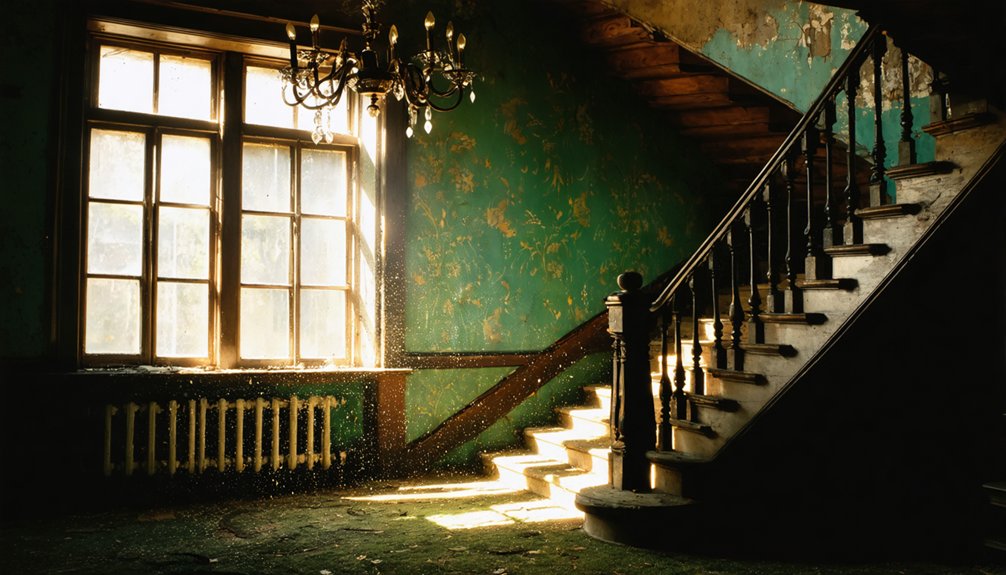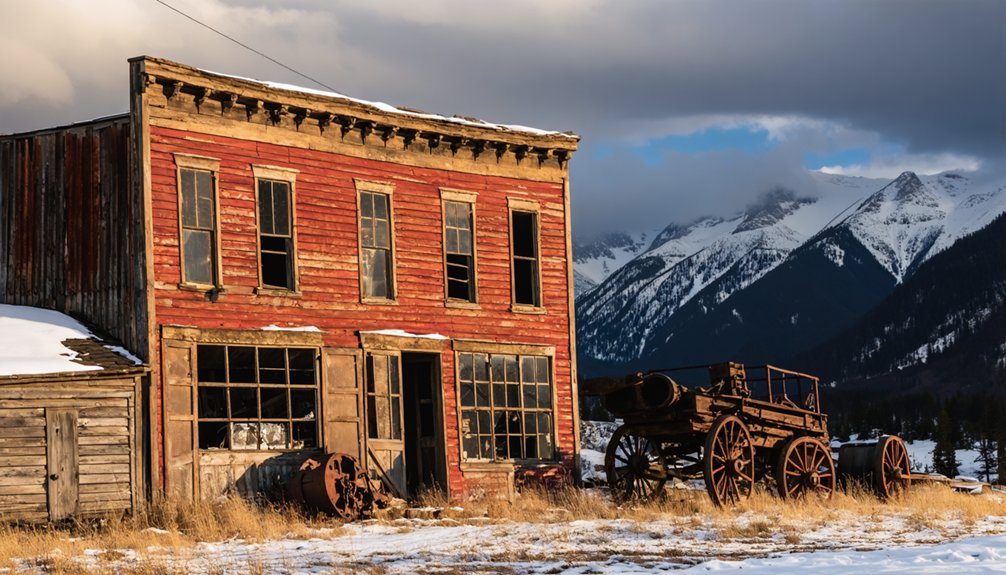Central City isn’t a true ghost town anymore. After Gregory’s 1859 gold discovery created “The Richest Square Mile on Earth,” the population plummeted from 20,000 to just 300 by the 1980s following devastating floods and mining closures. But unlike abandoned neighbors, Central City revived through legalized gambling in 1991, preserving its historic architecture and haunted reputation. The Victorian buildings that survived the 1874 fire tell tales of both tragedy and unexpected rebirth.
Key Takeaways
- Central City experienced dramatic population decline from 20,000 in the 1870s to 300 by the 1980s after gold mining declined.
- Known as “the most haunted square mile on earth,” featuring paranormal activity in the Masonic Cemetery and historic buildings.
- The town preserves 294 historic structures across 286.5 acres as a National Historic Landmark.
- Devastating floods in 1893 and 1895 accelerated Central City’s decline, resulting in loss of lives and mining operations.
- Gambling legalization in 1991 sparked economic revival, preventing Central City from becoming a complete ghost town.
The Gold Rush Origins: How Central City Became “The Richest Square Mile on Earth”
When John H. Gregory struck gold in a gulch between what would become Central City and Black Hawk on May 6, 1859, he couldn’t have known he’d just changed Colorado’s destiny forever.
This momentous gold discovery triggered a stampede of prospectors, swelling the population to 10,000 within mere months.
What began as Gregory’s Diggings—a sprawling collection of tents and makeshift shelters—quickly transformed into the legendary “Richest Square Mile on Earth.”
You could witness mining technology evolve from simple panning to sophisticated hydraulic operations and deep-shaft mining.
By 1867, over $9 million in gold had been extracted from lode deposits, while placer methods yielded another $241,918.
As mining advanced with dynamite and coal-powered drills, prospectors accessed gold-bearing quartz veins thousands of feet below ground, cementing Central City’s place in American frontier lore.
The arrival of the first steam engine in Mountain City in February 1860 marked a significant technological advancement that would revolutionize mining operations in the region.
Over time, the mining operations grew increasingly complex, with the deepest mine extending more than 3,000 feet below the surface.
From Boom to Bust: Central City’s Decline Into Ghost Town Status
Central City’s golden era wouldn’t last forever. By 1881, the opening of Denver’s Tabor Grand Opera House symbolized a shifting cultural landscape, diminishing Central City’s prominence.
The economic impact became evident as the population plummeted from 20,000 in the 1870s to merely 300 by the 1980s.
Devastating floods in 1893 and 1895 claimed miners’ lives and crippled operations. The 1895 disaster alone drowned 14 miners.
With over 17,000 abandoned mining claims in southern Gilpin County, the mining legacy transformed from wealth to liability. Safety hazards required sealing numerous mines. The town’s transition from placer to lode mining created additional technical challenges that contributed to its decline.
The town’s singular dependency on gold extraction proved fatal when resources depleted. Despite producing an astounding 6.3 million ounces of gold during its heyday, the boom couldn’t sustain itself. Without economic diversification, businesses failed as Central City slipped from Colorado’s largest town to near ghost town status by the early 20th century.
Historic Landmarks and Preserved Architecture of a Bygone Era
Despite its decline from a booming gold town to near abandonment, Central City’s architectural legacy stands as a tribute to its former glory.
When you stroll through this National Historic Landmark, you’ll encounter the opulent Teller House from 1872, the acoustically perfect Opera House with its frescoed ceiling, and the preserved Williams Stables and Gold Coin Saloon.
The town’s buildings showcase a blend of Second Empire, Italianate, and Queen Anne styles with intricate architectural details like ornate storefronts, iron columns, and corbeled entablatures.
After the 1874 fire, fireproof brick and stone construction became standard.
Today, preservation efforts protect 294 contributing structures across 286.5 acres, with a Historic Preservation Commission overseeing exterior changes to maintain the authentic character of this remarkable mining community. The Central City Opera House Association maintains 27 historic properties located throughout the historic district. Originally known as the Richest Square Mile on Earth, the area produced more gold than any other in the American West between 1859 and 1893.
Haunted History: Paranormal Tales From “The Most Haunted Square Mile”
Behind the preserved Victorian facades and historic landmarks lies a darker legacy that earned Central City its chilling nickname: “the most haunted square mile on earth.”
While visitors admire the architectural splendor by day, the town’s tragic past emerges after sunset, when shadows deepen across the deserted streets.
You’ll encounter Central City’s most famous spectral sighting at the Masonic Cemetery, where the mysterious “Lady in Black” visits John Cameron’s grave annually on November 1st.
The Lace House Museum delivers frequent ghostly encounters, from disembodied laughter to a shadow figure that follows guests throughout the building. Visitors regularly report hearing ghostly laughter and disembodied footsteps echoing through the historic building.
The town’s gold rush history—marked by disease, mining accidents, and violence—left behind countless souls whose stories echo through preserved buildings protected by local ordinances, ensuring their haunted legacies remain intact for you to experience. At the Visitor Center at 103 Eureka Street, employees have reported hearing loud footsteps from upstairs when no one is there.
Gambling Revival: How Legalized Gaming Breathed New Life Into Central City

When Colorado voters passed a constitutional amendment in November 1990, they unknowingly sparked a resurrection for the dying mining town of Central City.
The ballot box that November held more than votes—it contained the seeds of Central City’s unexpected revival.
Once “in bad shape” economically, this historic mining community found salvation through limited-stakes gaming. Local visionaries like Bruce Schmalz, inspired by Deadwood’s model, transformed family businesses into pioneer casinos. On October 1, 1991, the first legal wager marked Central City’s rebirth.
Family-owned establishments like Dostal Alley Casino, which began with just 44 slot machines, exemplify the town’s revitalization approach. Dostal Alley stands as a testament to local perseverance, being the only original casino from the first eight that opened in October 1991 still in operation today. Unlike Las Vegas, legal gambling here deliberately preserved Central City’s historic character while creating jobs and generating revenue for infrastructure.
Though facing stiff competition from neighboring Black Hawk, which grew into Colorado’s largest gaming center, Central City successfully balanced economic revitalization with its rich mining heritage. Mayor Jeremy Fey now envisions transforming the city into a cultural hub with festivals and entertainment, hoping to grow the population from 700 to 5,000 residents.
Beyond the Casinos: Cultural Heritage and Tourism Today
While Central City’s economic revival through gaming breathed new financial life into this historic mining town, it’s the rich tapestry of cultural heritage that truly defines its modern identity.
The National Historic Landmark Opera House, built in 1878, anchors the town’s cultural tourism scene with its renowned summer festival drawing 50,000+ visitors annually.
Beyond gambling, you’ll discover the Central City/Black Hawk Historic District with over 300 historic buildings meticulously preserved through active heritage preservation efforts.
The Opera House Museum and Gilpin County Historical Society offer immersive glimpses into the region’s mining past and cultural evolution.
Annual events like Heritage Days feature reenactments and traditional crafts, while educational walking tours illuminate the architectural significance of this former boomtown.
These cultural attractions diversify the local economy while preserving Central City’s authentic historical character.
Exploring Central City and Surrounding Ghost Towns: A Visitor’s Guide

To experience Central City‘s rich mining history, follow the self-guided walking tour that connects the Opera House, Teller House, and Masonic Cemetery in a 2-mile loop.
Don’t miss the hidden gem of Nevadaville, located just 3 miles west of downtown, where you’ll find remarkably preserved 1870s storefronts and mining structures without the crowds.
For the most thorough historical experience, combine your Central City exploration with the “Golden Circle” route that links nearby Russell Gulch and Idaho Springs, allowing you to visit three distinct mining settlements in a single day.
Best Tour Routes
Explorer’s paradise awaits in Central City and its surrounding ghost towns, offering visitors multiple ways to experience Colorado’s gold rush history and supernatural legends.
Begin with the self-guided Walking Tour starting at The Teller House, covering a half-mile in 45 minutes while discovering Central City’s boom-and-bust past.
For those seeking supernatural encounters, join US Ghost Adventures at the Masonic Cemetery to witness the “Lady in Black” phenomenon or investigate the Lace House Museum’s demonic growls.
Adventure seekers can explore nearby ghost towns like Independence (accessible via a one-mile hike) or Carson (requiring 4X4 access from Lake City).
Earth Treasures Tours offers extensive Ghost Tours ($95.95) including underground mines and haunted cemeteries.
ATV rentals provide access to remote sites like St. Elmo and Tin Cup.
Hidden Historical Gems
Beyond the well-trodden paths of Central City lie remarkable historical treasures that many visitors overlook. While exploring this “richest square mile on earth,” venture uphill to Nevadaville—a true ghost town at 9,050 feet elevation that once bustled with 4,000 residents.
Don’t miss Masonic Lodge #4, the only active lodge in a Colorado ghost town, preserving forgotten stories of mining-era fraternity.
Between paranormal investigations and historic preservation, you’ll discover hidden treasures in the town’s cemeteries. The Masonic and Odd Fellows cemeteries contain some of Colorado’s most haunted grounds, where restless spirits of miners reportedly linger.
For architectural enthusiasts, seek out the brick and stone buildings constructed after the devastating 1874 fire—silent witnesses to Central City’s remarkable resilience and golden legacy.
Frequently Asked Questions
What Was the Average Miner’s Daily Wage During Central City’s Heyday?
During Central City’s golden times, your miner’s livelihood brought a handsome $5 daily in the 1860s, though wage fluctuations eventually settled around $3 by the early 1900s.
Were Any Notable Movies or Television Shows Filmed in Central City?
You’ll recognize Central City’s authentic Western backdrop in “Centennial” (1978) and “The Duchess and the Dirtwater Fox” (1976). Local legends often enhance the town’s film history appeal for period productions.
How Did Women Contribute to Central City’s Development and Economy?
You’ll find women entrepreneurs tremendously shaped Central City through businesses like boarding houses, laundries, and shops. They’re also responsible for essential community support through education, social events, and charitable work.
What Indigenous Tribes Inhabited the Area Before Central City’s Founding?
While you might assume various tribes lived there, the Ute people were the primary Native Tribes in the area, calling themselves “Nuche.” They maintained their Cultural Heritage through seasonal migration patterns in Colorado’s mountains.
How Did Prohibition Affect Central City Compared to Other Mining Towns?
You’ll find Prohibition hit Central City harder than most mining towns, severing the saloon-grubstaking system that kept prospectors afloat while the already-declining mining economy couldn’t absorb the additional economic shock.
References
- https://k99.com/central-city-may-be-the-most-haunted-place-in-colorado/
- https://americanghost.blog/2023/09/12/central-city-colorado/
- http://www.hauntedcolorado.net/Central_City.html
- https://usghostadventures.com/haunted-stories/central-city-masonic-cemetery/
- https://www.uncovercolorado.com/ghost-towns/nevadaville/
- https://www.legendsofamerica.com/co-centralcity/
- https://www.visitcentralcity.com/history
- https://www.goworldtravel.com/central-city-colorado/
- https://www.gilpinhistory.org/central-city
- https://westernmininghistory.com/towns/colorado/central-city/



